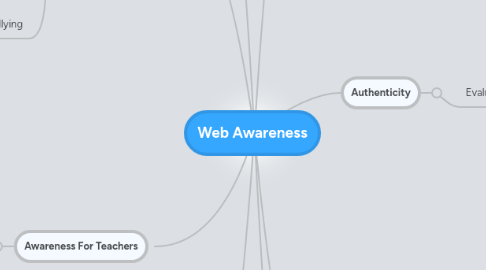
1. Awareness For Teachers
1.1. Possible Threats
1.1.1. Websites with malicious content
1.1.2. Dangerous advertisements
1.1.3. Revealing personal identification
1.2. Issues that may appear
1.2.1. Hacking
1.2.2. Viruses
1.2.3. Unwanted communication
1.3. Promoting Safety
1.3.1. Being conscious while browsing
1.3.2. Developing steps for ethical web-use
1.3.3. Understanding what a good site looks like
2. Sexually Explicit Content
2.1. How are children exposed to sexual content?
2.1.1. Accidentally
2.1.1.1. Televsion
2.1.1.2. Internet
2.1.2. Intentionally (Curious)
2.1.2.1. Seek out info
2.1.2.2. Find someone that will help seek info
2.2. Possible Impacts of Overexposure
2.2.1. Encourage sexual acts without emotional connection
2.2.2. Prematurely shape sexual attitudes, values, behaviours
2.2.3. Increase social acceptance of high risk behaviour
2.2.4. Cause increased health risks
2.2.5. Interfere with healthy sexual development
2.3. What can parents do?
2.3.1. Be aware of what children are engaging in on-line
2.3.2. Have an open, welcoming talk regarding mature subjects
2.3.3. Explain the media's misrepresentation of relationships
2.3.4. Configure content filter on-line
3. Cyberbullying
3.1. Preventing any form of bullying
3.1.1. Speaking with students and parents about effects of bullying
3.1.2. Have workshops that inform and demonstrate negative effects of bullying
3.2. Effects of bullying
3.2.1. Decreased self-esteem, unwillingness to risk and explore
3.2.2. Poor grades, feeling disconnect with school, peers and family
3.2.3. Increased chance of turning to drugs and alcohol to escape pain of bullying
3.3. Eliminating all bullying
3.3.1. Teaching students as early as possible about the effects of bullying
3.3.2. Reinforce consequences for anyone caught participating in an act of bullying
4. Internet Safety
4.1. Effective Filtering Systems
4.1.1. How much?
4.1.2. Knowing what is and is not appropriate
4.2. Issues with Media
4.2.1. Body Image
4.2.2. Gender
4.2.3. Diversity
4.3. Issues with on-line programs
4.3.1. Time-wasters
4.3.2. Ineffective outcomes
4.3.3. Playing games
4.3.4. Watching & sharing videos
5. Authenticity
5.1. Evaluating On-line Content
5.1.1. Authority
5.1.1.1. Is author's qualifications/contact information available?
5.1.1.2. Is the author associated with an educational institution/reputable organization?
5.1.2. Coverage
5.1.2.1. Is the information relevant to your topic?
5.1.2.2. Is the material useful? How in-depth is it?
5.1.3. Objectivity
5.1.3.1. Does the information show a minimum of bias?
5.1.3.2. Does the page presents facts and refrain from swaying opinion?
5.1.4. Accuracy
5.1.4.1. Is information reliable and free of mistakes?
5.1.4.2. Is there a current update to be seen?
5.1.5. Currency
5.1.5.1. Is the page dated?
5.1.5.2. Are the links effective in directing to existing pages?
6. Copyright
6.1. Reasons for Copyright
6.1.1. Reward author(s) for contributions
6.1.2. Encourage people to create without fear of being stolen from.
6.2. What can be Copyrighted?
6.2.1. Only materialized ideas can be copyrighted.
6.2.2. The Copyright owner may produce, reproduce, publish, or translate his/her work.
6.3. How is Copyright protected?
6.3.1. Owner may use the court to protect work that he/she believes is bring used unlawfully.
6.3.2. Fines or jail time may occur for those who attempt to use others' copyrights illegally.
7. Marketing
7.1. Pester Power
7.1.1. Relying on kids to bother their parents into getting them to buy what they want.
7.2. Psychology and Marketing
7.2.1. Advertisers have access to knowledge regarding developmental, emotional, and social needs in children at different ages.
7.3. The Internet
7.3.1. Parents are unaware of extent to which their kids are marketed to on-line.
7.4. Buzz/Street Marketing
7.4.1. "Word of mouth" strategy involves getting "cool" students to wear desired products for a company.
8. Privacy (Issues to consider)
8.1. Audience
8.1.1. Anything published can be seen by anyone
8.1.2. We don't have total control over everyone who views our published content
8.2. Anonymity
8.2.1. Using a pseudonym can help preserve identity
8.2.2. We must still consider the possibility of tracing anything back to its source (digital footprint)
8.3. Permanence
8.3.1. Can be seen for years to come
8.3.2. Consider who can/will see your published activity. What will they think?
8.4. Copyright
8.4.1. Do not plagiarize
8.4.2. Taking credit for making something that someone else created is wrong and punishable by law.
8.5. Free Speech
8.5.1. Having the right to free speech does not mean we can say anything we want.
8.5.2. How will what I say affect others? Myself?
